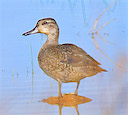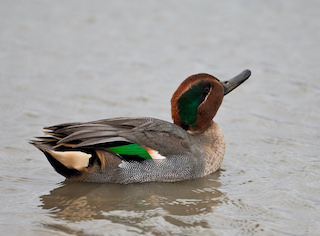 In the colder months, watch out for overwintering Teal on pools and marshes around The Lizard. Windmill Farm is a good place to look.
In the colder months, watch out for overwintering Teal on pools and marshes around The Lizard. Windmill Farm is a good place to look.
Photo: Dougy Wright
Scientific name: Anas crecca
Other common names: Eurasian Teal, Common Teal
Conservation status: IUCN Red List: Least Concern; UK Birds of Conservation Concern, Amber
What to look for:
• Colouring and appearance: A small duck: males in breeding plumage have chestnut heads, deep green eyes patches, a yellow tail with black edges, grey back and flanks, and a spotted chest. They are duller outside of the breeding season. Females are a dull speckled brown. Both sexes have emerald green wing patches (speculum), which are retained in winter plumage.
• Size: Wingspan 61 cm, length 36 cm.
• Where: Teal breed in the north of the UK, but flock together in the winter further south, where they are joined by birds from Siberia and the Arctic.
• Call: Listen here
• Similar species: Mallard (Anas platyrhynchos), males of which have a blue speculum (as does the female), and a completely green head.
 Breeding in fairly small numbers in the UK (2100 pairs), mainly on northern moors, numbers of Teal swell in the winter as they head further south and are joined by other Teal from Siberia and the Baltic. Some 210,000 individuals overwinter in the UK (source: BTO), and this forms a large percentage of the overwintering population in NW Europe, hence the UK Amber Status of this gregarious duck species. Important winter populations can be found on the Somerset Levels, but you can also see Teal on wetlands across Cornwall, forming large flocks.
Breeding in fairly small numbers in the UK (2100 pairs), mainly on northern moors, numbers of Teal swell in the winter as they head further south and are joined by other Teal from Siberia and the Baltic. Some 210,000 individuals overwinter in the UK (source: BTO), and this forms a large percentage of the overwintering population in NW Europe, hence the UK Amber Status of this gregarious duck species. Important winter populations can be found on the Somerset Levels, but you can also see Teal on wetlands across Cornwall, forming large flocks.
 As is typical of many duck species, the males (drakes), with their chestnut and deep-green heads, are more resplendent than the more muted females in the breeding season. Of course, the reason the females are a duller colour is because, like other ducks, they take sole charge of rearing the young, and so camouflage is important. They lay up to ten eggs in April/May. The precocious young hatch three weeks later, and quickly follow their mother into the water to learn how to feed and survive.
As is typical of many duck species, the males (drakes), with their chestnut and deep-green heads, are more resplendent than the more muted females in the breeding season. Of course, the reason the females are a duller colour is because, like other ducks, they take sole charge of rearing the young, and so camouflage is important. They lay up to ten eggs in April/May. The precocious young hatch three weeks later, and quickly follow their mother into the water to learn how to feed and survive.
This is a dabbling duck species (ie. it is a surface rather than diving feeder, often seen ‘upending’ in the water as it searches for food), eating invertebrates, water weed and seeds.
Did you know…?
…The genus name Anas simply means ‘duck’, while the species name crecca is derived from the Swedish word for Teal (‘kricka’), which in turn is derived from the bird’s characteristic ‘cric’ call. So its scientific name means, literally, ‘duck that says cric’.
…The Teal is the smallest dabbling duck in Europe.
More information and references:
Svensson, L., Mullarney, K., Zetterstrom, D.,1986. Collins Bird Guide, second edition (translated by Christie, D., Svensson, L.). HarperCollins, London.
Published: October 2016
Author: Amanda Scott
Photos: Dougy Wright (upper photo); © Natural England/Allan Drewitt (lower photo)
